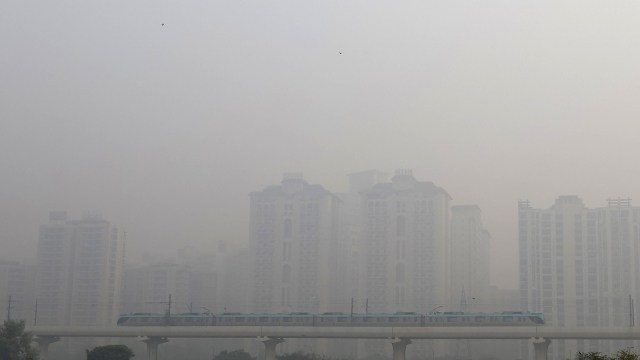AQI still in the severe zone, share of farm fires in pollution spike increases
The temperature, meanwhile, is not expected to see much change and there is no chance of rain.
 Sunday’s AQI was 454, a deterioration from 415 recorded on Saturday. (Express Photo by Gajendra Yadav)
Sunday’s AQI was 454, a deterioration from 415 recorded on Saturday. (Express Photo by Gajendra Yadav) A slew of measures to curb pollution in Delhi came into force on Sunday as the city’s air quality index (AQI) crossed the 450-mark for the second time this season. Sunday’s AQI was 454, as opposed to 468 on Friday. It had improved to 415 on Saturday.
This came even as the number of farm fires in Punjab rose to 3,230 and to 109 in Haryana. Despite the increase in fires over the past few days, the figures are still lower than those recorded over the past few years between September 15 and November 5. (see box)
According to the Decision Support System of the Indian Institute of Tropical Meteorology (IITM), the contribution of biomass burning in Delhi’s pollution was around 20% on Sunday. It has been above the 15% mark on all days, barring three, since October 22 and it peaked on Friday with over 35%, coinciding with the city’s worst recorded air day, so far this season.
According to senior Delhi government officials, the combination of adverse weather conditions and an increase in the input of pollutants in the form of farm fires means that the situation is not expected to improve anytime soon. “What Delhi needs right now is a spell of rain and strong winds.
Because of Delhi’s geographical position – with the Aravalli mountain range on one side, the Malwa and Deccan plateaus a few hundred kilometres to the South and the Himalayas to the North, the entire belt from Haryana to Bihar is ideal for trapping pollutants. If you look at the other cities in this area, they are facing a similar condition. What pushes it over the edge in October and November is the dip in temperature and calm winds, and to an extent the farm fires. Even after the farm fires stop, the air will mostly remain in the very poor category,” said an official.
Cities and towns such as Bhiwadi (413), Faridabad (450), Greater Noida (410), Gurgaon (402), Noida (414) and Kaithal (434) also remained in the severe category.
According to the Air Quality Early Warning System, the city will remain in the severe category for at least the next six days. The wind coming from the northwest direction will bring smoke and particulate matter with it from over Punjab and Haryana, on Monday. The speed, however, will remain between 4 and 6 kilometres per hour. The ideal wind speed for the dispersion of pollutants is around 10 kilometres per hour. The speed may increase to around 12 kilometres per hour on Tuesday, but the direction will be northwesterly. This is expected on Wednesday as well, as per the forecast.
The temperature, meanwhile, is not expected to see much change and there is no chance of rain.







